 Technology
Technology  Technology
Technology  Humans
Humans 10 Everyday Human Behaviors That Are Actually Survival Instincts
 Animals
Animals 10 Animals That Humiliated and Harmed Historical Leaders
 History
History 10 Most Influential Protests in Modern History
 Creepy
Creepy 10 More Representations of Death from Myth, Legend, and Folktale
 Technology
Technology 10 Scientific Breakthroughs of 2025 That’ll Change Everything
 Our World
Our World 10 Ways Icelandic Culture Makes Other Countries Look Boring
 Misconceptions
Misconceptions 10 Common Misconceptions About the Victorian Era
 Mysteries
Mysteries 10 Strange Unexplained Mysteries of 2025
 Miscellaneous
Miscellaneous 10 of History’s Most Bell-Ringing Finishing Moves
 Technology
Technology Top 10 Everyday Tech Buzzwords That Hide a Darker Past
 Humans
Humans 10 Everyday Human Behaviors That Are Actually Survival Instincts
 Animals
Animals 10 Animals That Humiliated and Harmed Historical Leaders
Who's Behind Listverse?

Jamie Frater
Head Editor
Jamie founded Listverse due to an insatiable desire to share fascinating, obscure, and bizarre facts. He has been a guest speaker on numerous national radio and television stations and is a five time published author.
More About Us History
History 10 Most Influential Protests in Modern History
 Creepy
Creepy 10 More Representations of Death from Myth, Legend, and Folktale
 Technology
Technology 10 Scientific Breakthroughs of 2025 That’ll Change Everything
 Our World
Our World 10 Ways Icelandic Culture Makes Other Countries Look Boring
 Misconceptions
Misconceptions 10 Common Misconceptions About the Victorian Era
 Mysteries
Mysteries 10 Strange Unexplained Mysteries of 2025
 Miscellaneous
Miscellaneous 10 of History’s Most Bell-Ringing Finishing Moves
10 Straight-From-Hell Statues You Can’t Unsee
Mankind has been putting up statues for generations upon generations. It’s a way to remember those who have made invaluable contributions, a way to memorialize events and, sometimes, a way to remind people passing by that life ends the same for all of us. And there’s a good chance that quite a few of us are going to be burning in Hell—probably still haunted by some of these statues.
10Blucifer
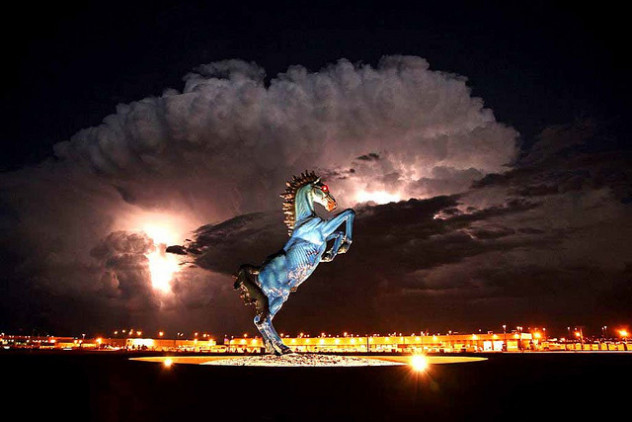
Blucifer is terrifying, and it’s made even worse by its location just outside the Denver Airport. Blucifer isn’t actually the statue’s name; it’s just one of a handful of affectionate nicknames that the people of the city have given him. Other nicknames include the Blue Stallion of Death and Satan’s Steed. The more accurate name is Blue Mustang, but it’s incredibly easy to see where he’s gotten his terrifying monikers from. It’s a rearing, snorting, anatomically correct horse—in theory. But with its glowing red eyes, we’re pretty sure that it’s Satan’s Steed.
Not surprisingly, many people who live in Denver hate it. And it wasn’t good luck for its creator, either. Artist Luis Jimenez was working on the nearly 10-meter-tall (32 ft), 4,100-kilogram (9,000 lb) statue when it killed him. A piece of the statue fell on him, severing an artery in his leg.
As if that isn’t bad enough, conspiracy theorists have also pointed to the horse as a rather in-your-face sort of confirmation as to what they’re convinced the Denver International Airport really is: a secret base that’s going to be kick-starting the revolution. When construction on the airport went well over budget and dragged on for several more years than planned, rumors started circulating that the added time and money were needed to build a massive, underground bunker and military facility where the government would be restarted after the rest of the world ends. Now, some think that the horse is pretty obvious proof as it’s clearly supposed to be representative of one of the horses of the apocalypse in the Book of Revelation.
9San Jose’s Quetzalcoatl
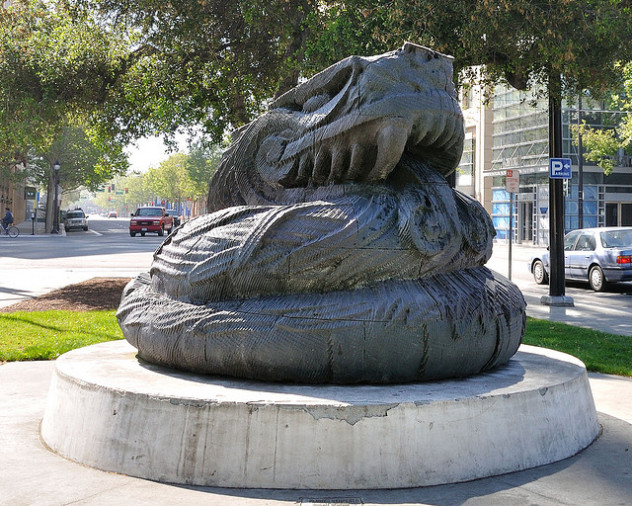
Quetzalcoatl is an ancient Aztec god that is part serpent, part feathery, fiery dragon. He’s at the top of the pantheon for a good reason, and he’s majestic. It seems like he would also be what artists would only dream of getting a commission to build, especially a commission on the scale approved in San Jose, California.
In 1992, sculptor Robert Graham was asked to create a statue that would not only be a central artistic attraction for the city but that would honor the current Hispanic families that called the city home, as well as the people that had founded it and lived on the land before. So, Quetzalcoatl it was.
We’re not sure if he was just too ambitious or if he just gave up once he got the staggering $500,000 the city gave him. Originally, his plans included a huge bronze statue but, gradually, those plans turned into something else. While the city’s art council agreed to the new design, he didn’t get opinions from anyone else. He’d been faced with unhappy customers before, so he kept the design under lock and key until the unveiling.
That’s when people promptly started putting their little dogs on top of the statue for some pretty predictable yet, let’s face it, still humorous photos.
Once the amusement wore off, people realized they were stuck with the statue which was insulting on a couple of levels. Some people didn’t want that part of their heritage remembered at all since Quetzalcoatl was one of the gods that supposedly taught the art of removing the heart from a sacrifice while it was still beating. And others were pretty sure that he wouldn’t like being depicted as poop, even if he was on a pedestal.
Hundreds of people turned out in protest of the statue, making the unveiling just another chapter in San Jose’s worst civic nightmare. This was the second attempt at creating a cultural centerpiece that failed miserably. The first was the unveiling of a statue of the 19th-century military leader who first captured San Jose and took control of the area from Mexico.
8Prague’s Faceless Babies
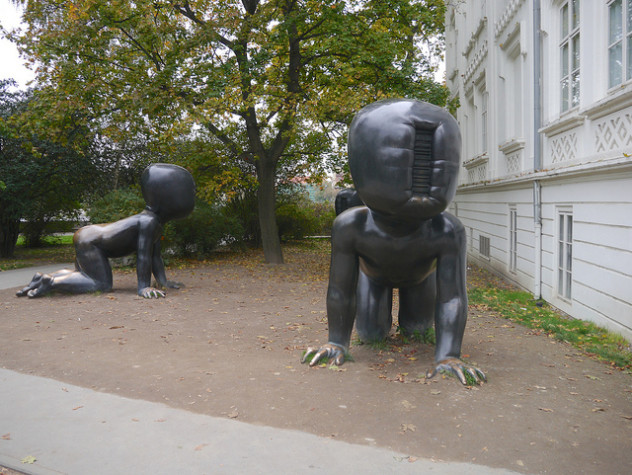
Prague is a weird place. It’s also home to the Zizkov Tower, a 216-meter (708 ft) eyesore that’s the tallest building in the country. It’s received one of the “Best In” awards, and it’s also called the second-ugliest building in the country.
Rather than just accepting the “ugly building” title, the city attempted to make the building more attractive and at least a little more culturally acceptable. And, apparently in Prague, that means adding art that could fuel many nightmares.
In 2000, 10 giant, faceless babies were added in various places around the tower, crawling up and down it. They are the work of one of the city’s creepiest and most controversial artists, David Cerny. The big fiberglass babies are also invading Kampa Park.
Sitting in Kampa Park are three more babies, and they might be even more terrifying (if that’s even possible). Made of bronze instead of fiberglass, visitors can now see that the little tots aren’t entirely faceless, though they do have weird vortex-like, misshapen, pizza-dough heads. Have their faces disappeared or been sucked inside-out? We’d rather not know, actually.
7The Virgin Mother And Verity
As artists go, Damien Hirst is pretty controversial. (We talked about him previously, including his opinions on the difference between stealing from someone and paying tribute to them.) But that’s not the only reason he’s controversial. His statues of the Virgin Mother and Verity give passers-by absolutely no choice but to see them.
Both Verity and the Virgin Mother are huge and pregnant. You can tell because they’ve been partially flayed to reveal everything inside, from muscle tissues to the unborn fetus. And did we mention they’re huge? The Virgin Mother is 10 meters (33 ft) tall and weighs 13 tons. In 2014, she was purchased by a real estate tycoon in Manhattan whose neighbors promptly waged war on him.
And Verity, made with much the same “flayed pregnant woman” motif, is even larger. She stands more than 20 meters (66 ft) tall, holding a sword over her head from where she looks out over North Devon. According to Hirst, she’s on long-term loan to the English seaside town, but some residents are, understandably, a little less than thrilled. While some call it a brilliant sort of tourist attraction, others think it’s a little too “Hannibal Lecter-ish.”
Verity was installed on the harbor on a 20-year loan program. It wasn’t entirely done out of the goodness of the artist’s heart, though. Hirst has a home nearby, as well as a restaurant that overlooks the monstrosity of a statue. The restaurant has been regularly full ever since.
6The Headless Monument
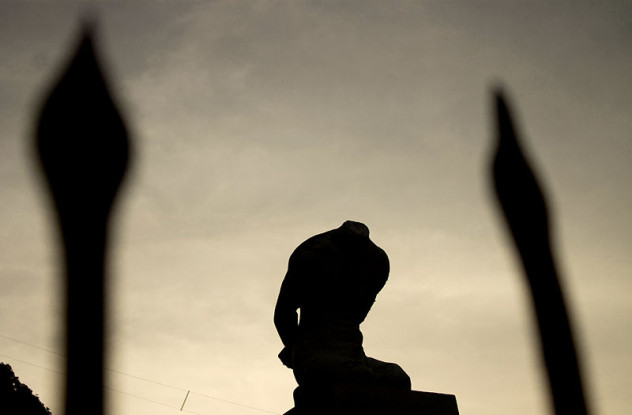
Sitting outside the post office of Legazpi City in the Philippines is a pretty disturbing sight: a monument with a kneeling, headless figure on top, his position suggesting that the blade had only fallen seconds before. The statue is surrounded by more questions than answers.
One of the more official versions of the story is that the statue is a memorial to local Bicolano war heroes that had died during World War II. The Bicolano are certainly no strangers to war. There’s another statue (a far less creepy one) that sits in Naga City and commemorates the Bicolano martyrs whose executions spurred on local support for the Philippine Revolution.
Local lore holds that on November 22, 1945, laborers discovered a headless body buried in the sand of Sabang’s Albay Gulf. It was thought that he hadn’t been there long since his uniform was still incredibly intact. But his head was missing. The benefactor of one of the city’s colleges wanted to preserve the memory of the man and had the statue commissioned but only after the body was displayed through the town in the middle of a parade.
How true that is, we’re not sure. There are no remaining documents that trace the history of the headless body or the commission of the statue, although quite a few people claim to remember it all happening. Local historians have no idea what the real story is, and neither does the country’s National Historical Institute.
5The Cloak Of Conscience
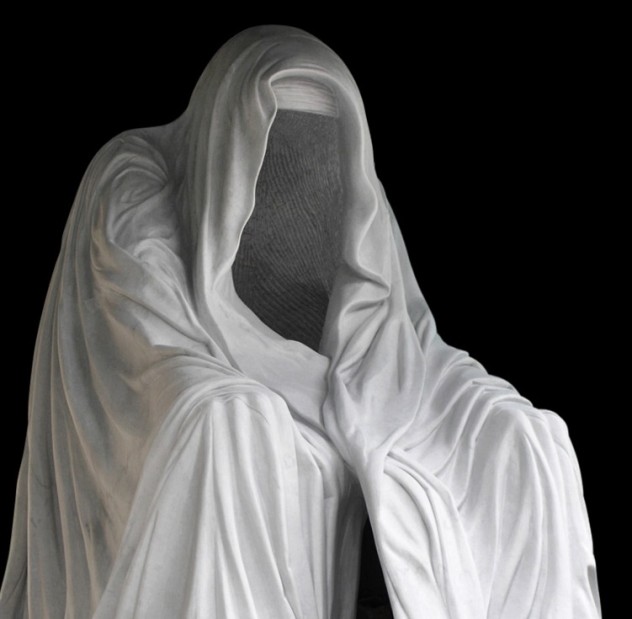
The Cloak of Conscience is the sort of terrifying that’s strangely beautiful as well. There are a handful of different versions of it that continuously pop up throughout artist Anna Chromy’s work and across Europe. The cloaked figure with eyes cast downward and shoulders slumped first appeared in the background of a painting she did in 1980. Even then, it wasn’t meant to depict an actual figure. It was empty and depicted how nothing was left of an old woman but a tattered cloak.
The theme popped up again when she first turned to sculpture. This time, the theme appeared in the form of an empty coat that was meant to symbolize the road that we all walk in life—a road that is given shape by our conscience. The reaction was incredible, and she decided to create the the empty cloak version. She had created a handful of relatively normal-sized installations of empty cloak sculptures before creating the Archi-Sculpture.
Even the marble for the sculpture has an incredible history. It’s from the same quarry that supplied the marble for Michelangelo’s works. It’s the only quarry in the world that can still produce a piece of marble that big, and the one needed for Chromy’s weirdly sinister, empty sculpture was 200 tons. It was so big that much of the initial work was done at the quarry.
Smaller versions of the cloak have been installed at various locations across Europe, from Rome to Monaco to Prague.
4Wickham’s Headless Statue Park
Sitting along a road in rural Palmyra, Tennessee are an eerie collection of statues. They weren’t always unsettling, and they weren’t meant to be that way. After the death of their creator, Enoch Tanner Wickham, the statues fell victim to not only the wear and tear of the Tennessee weather but also the the vandalism of the backcountry roads. The statues were painstakingly crafted over two decades as a labor of love by a tobacco farmer who, in his retirement, found he could finally embrace his love of art and sculpture.
There are birds and oxen, several men on horseback, and groups of people. There’s Tecumseh, Andrew Jackson, and even a bull standing alongside Daniel Boone and Sitting Bull. But after Wickham’s death in 1970, bad things started happening to the statues which left them truly looking like something out of a horror movie set in the backwoods of the Deep South.
None of them have managed to keep their heads, and most are missing limbs, too. They’re riddled with bullet holes, they’ve been rammed and run over by trucks, pieces smashed and knocked off their pedestals. Those pedestals, once inscribed with names and a short verse about their importance in the country, are just as defaced.
The result isn’t just eerie; it’s sad. Attempts to save some of the pieces have been made, and some have been relocated and protected behind wire fencing. It’s a pretty tragic end to the work of a man who had been a sculptor for no other reason than he loved it, and a man who once had a senator speak at the unveiling of his World War II monument, dedicated to his own son, who had given his life in the war.
3Neb-Sanu, The Moving Statue
Sitting in a glass case in the Manchester Museum in England, the ancient Egyptian statue of Neb-Sanu looks pretty much like your typical Egyptian statue. It’s small, only standing about 25 centimeters (10 in) high, but the weirdness started happening when the statue started moving inside its locked glass case.
For a while, no one actually saw it moving. Curators would notice that it had turned at varying angles throughout the day, seemingly at random. It was weird enough that they set up a camera to track the statue, and the resulting time-lapse video does, indeed, show it moving throughout the day.
The statue is about 4,000 years old and was originally an offering to Osiris. It had been in the museum’s collection for around 80 years without any strange occurrences attached to it, but the movement brought out all the theories. Some suggested that it was actually housing the spirit of the man it had been carved to represent, while another theory speculated that the statue, which would turn 180 degrees and no further, was turning to show passers-by the inscription on its back which gives instructions for the sacrifice of “bread, beer, oxen, and fowl.”
The actual explanation was much more mundane and disappointingly boring. Physicist Brian Cox got involved in the mystery, and pointed out that it was the minute vibrations creating differential friction between the glass shelf and the statue making it turn on its own.
2Saint Wenceslas On A Horse
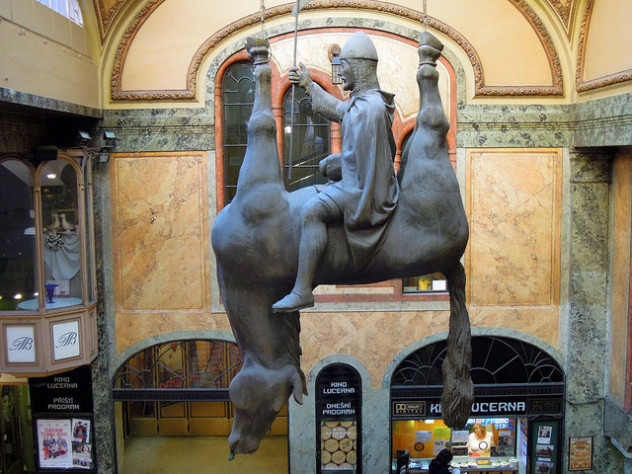
Saint Wenceslas was created by the same artist who made the giant, faceless crawling babies. For a bit of context, Saint Wenceslas is the country’s patron saint, and another statue of him (a much more majestic, less terrifying statue) sits at the top of Wenceslas Square in Prague, riding a perfectly normal horse.
David Cerny’s Saint Wenceslas sits not just on a dead horse, but on a horse that is strung up, upside-down by its feet. It has a limp body, lifeless head, and protruding tongue. When it was installed at the opposite end of Wenceslas Square, the dead horse presented an even more bizarre contrast to the proud figure of the saint that straddled it. The statue’s face bore a striking resemblance to then-president Vaclav Klaus, and this did not go unnoticed.
The depiction of the saint isn’t just pretty sacrilegious. It’s been interpreted as downright revolutionary. The upright, normal statue of the saint at the other end of the square has long been a central point and gathering place for the city’s people. It was where they celebrated their triumphs and gathered in times of crisis. Its inscription was a reminder of their strength and a plea for perseverance, which makes the other Wenceslas, with his ghastly dead horse, even more disturbing.
There’s an interesting bit of folklore that goes along with Saint Wenceslas, too. Much like Britain’s Arthur, it’s said that Wenceslas and his knights are simply sleeping and waiting until their country needs them, at which point they’ll once again ride.
1Wang Saen Suk: Buddhist Hell
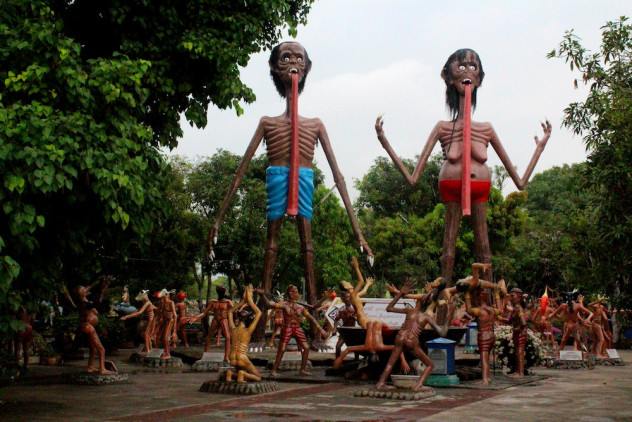
Buddhist tradition is most well known for its ideas about reincarnation. Getting another chance to make a go of life is an incredibly attractive idea. Less attractive is the idea that there’s a waiting period before you get a new body. When a person dies, their deeds are measured and weighed. If the bad outweighs the good, your soul is going straight to Hell to pay for those evil deeds before you get another body. A particularly evil soul can spend thousands of lifetimes waiting and paying for their misdeeds in Buddhist Hell. In case you’ve ever wondered what Naraka actually looks like, visit Wang Saen Suk.
The two statues that welcome you to the park (if “welcome” is the right word) are the male and female preta. They’re a pretty horrific-looking pair that walk the Earth in perpetual thirst and starvation. Like many types of spirits and otherworldly creatures, there are some different interpretations as to what a preta is aside from a spirit that’s paying for its worldly sins. There are preta that can only eat vomit, pus or, for some reason, moths, and there are preta whose punishment is having a throat so narrow that they always feel like they are choking, unable to eat, drink, or breathe. Some preta are immense, constantly weeping or burning, or constantly floating in the wind.
As if that isn’t enough of a deterrent to sin, the whole place is crawling with statues that leave little to the imagination and show visitors exactly what’s going to happen if they deviate from the path of light and good. Men are sawed in half or crushed in a vice, while others are condemned to wander, bleeding from weapons that have been lodged in them. Animal-headed men are beaten, while birds feed on the innards of the screaming.
That’s all pretty bad, but there’s an extra-special place that’s reserved for one specific type of sinner: those who have physically abused their own parents or a monk. There’s a special pit in hell for them, and they’re not going to be going anywhere until the birth of the new Buddha.

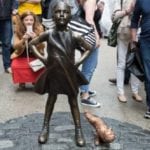
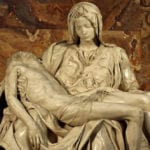
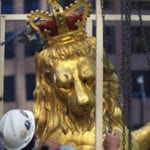
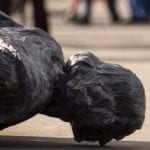

![10 Real Countries Straight Out Of The Handmaid's Tale [DISTURBING] 10 Real Countries Straight Out Of The Handmaid's Tale [DISTURBING]](https://listverse.com/wp-content/uploads/2019/11/offredandafghan-150x150.jpg)

